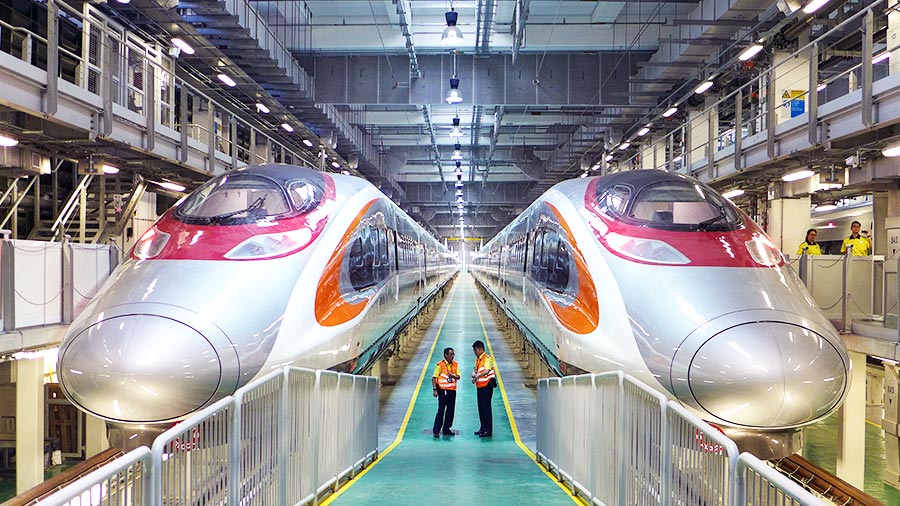
On September 23, the final phase of the Guangzhou–Shenzhen–Hong Kong express rail link (XRL) will be completed, connecting Hong Kong with mainland China’s high-speed rail system.
Built at a cost of US$10.8 billion, amid multiple delays and cost overruns, the Hong Kong section of the high-speed rail line cuts down rail travel times to major cities in mainland China.
Travelling from Hong Kong to Guangzhou, in the neighboring Guangdong province in South China, will now take less than 50 minutes – down from two hours currently.
The project is expected to strengthen Hong Kong’s status as an international logistics hub.
The high-speed rail project was first proposed in 2000, alongside other mega-infrastructure initiatives, to boost GDP and employment.
Yet, Hong Kong locals often rue the overall impact of the rail project – citing the displacement of people, huge costs, and limited advantages of securing additional transport options with the mainland. MTR Corporation, which is responsible for the transport line’s operations, has also been beleaguered with scandal and crises at management.
Nevertheless, proponents of the high-speed rail line highlight its importance to the region’s larger infrastructure programs. The final phase, connecting Hong Kong with the mainland, means the region will be well connected to China’s Belt and Road Initiative plans.
Further, easier and faster connectivity ensures Hong Kong’s place in China’s Greater Bay Area (GBA) initiative, a mainland scheme to turn Hong Kong and its neighboring cities into a financial and innovation hub, akin to Silicon Valley in the US. The proposed cities in the GBA scheme are: Hong Kong, Macau, Guangzhou, Shenzhen, Zhuhai, Foshan, Zhongshan, Dongguan, Huizhou, Jiangmen, and Zhaoqing.
Overall, the high-speed rail will connect Hong Kong with China’s over 25,000 km long National High Speed Rail Network. The enhanced linkage between Hong Kong and cities further in the mainland will boost inter-regional economic exchanges, tourism, and trade.
The high-speed rail will also complement Hong Kong’s pillar industries – the financial services, trading, and professional services sectors, in addition to creating new jobs in the operation, maintenance, services, and retail segments.
A unique aspect of the Hong Kong high-speed rail’s West Kowloon terminus is a ‘co-location’ arrangement with mainland China.
This means that security at the terminus will be handled by checkpoint officials from the mainland. Portions of the terminus complex will also come under mainland China’s jurisdiction and will be subject to its laws.
The arrangement, approved after a difficult vote in June, is a highly contentious matter. Legal experts in Hong Kong fear that it sets a precedent for the future dilution of Hong Kong’s Basic Law, the city’s mini-constitution. Mainland officials, however, maintain that Hong Kong will retain its high degree of autonomy.
Critics of the Hong Kong speed rail link remain bewildered by the government’s optimistic financial goals. They state that multiple and more affordable options already exist along the same routes.
For instance, Hongkongers making shorter trips can travel to Lok Ma Chau to cross the border into Shenzhen by taking the MTR Corp’s East Rail from Hung Hom, which costs HK$38 (US$5) one-way. Contrast this with stations on the high-speed rail – it will cost Hongkongers HK$78 (US$10) and HK$86 (US$11), respectively, to travel to Futian and Shenzhen North, both stations in the city of Shenzhen.
The existing train network connects daily commuters from Hong Kong to centrally located stations in Guangzhou in less than two hours; the new high-speed rail will bring it down to between 48 and 71 minutes.
What this suggests is that daily commuters might not switch to the speed-rail whole-scale, with only a portion of passengers choosing the faster, more expensive option.
Promoters of the high-speed rail seek to offset the criticism by citing long-term growth potential as well as “competitive” ticket pricing, among other conveniences.
Since opening ticket sales on September 10, the cross-border railway has suffered multiple glitches and lower than expected demand.
Besides technical difficulties due to errors in the ticketing system and non-recognition of older generation cross-border permits, confusion soon spread over the extension and applicability of mainland China’s ‘blacklist’.
The blacklist is used by Chinese authorities to track people deemed as ‘untrustworthy’. Currently, it only applies to mainland Chinese, but it will be extended to Hongkongers once the rail link opens.
Getting on the list means the person has previously been found guilty of public offences such as smoking and gambling, misbehaving on flights and trains, not paying back debts, or “other behaviors”.
A person who is on the blacklist will not be able to access a variety of services, including using the high-speed train.
About Us
China Briefing is produced by Dezan Shira & Associates. The firm assists foreign investors throughout Asia and maintains offices in China, Hong Kong, Indonesia, Singapore, Russia, and Vietnam. Please contact info@dezshira.com or visit our website at www.dezshira.com.
Our free webinars are packed full of useful information for doing business in China.
Meet the firm behind our content. Visit their website to see how their services can help your business succeed.
Subscribing grants you this, plus free access to our articles and magazines.
Subscribe to receive weekly China Briefing news updates,
our latest doing business publications, and access to our Asia archives.
Sign up for your complimentary subscription to our weekly newsletter here.
No subscription charges!
Type keyword to begin searching…
